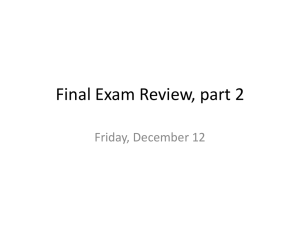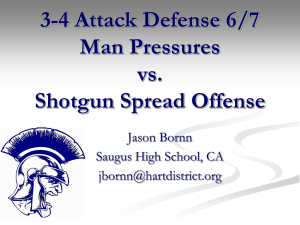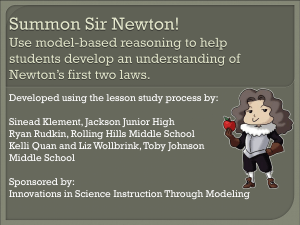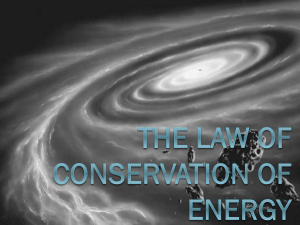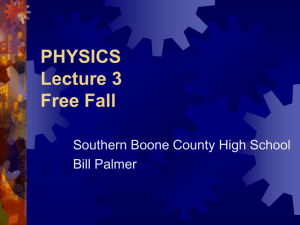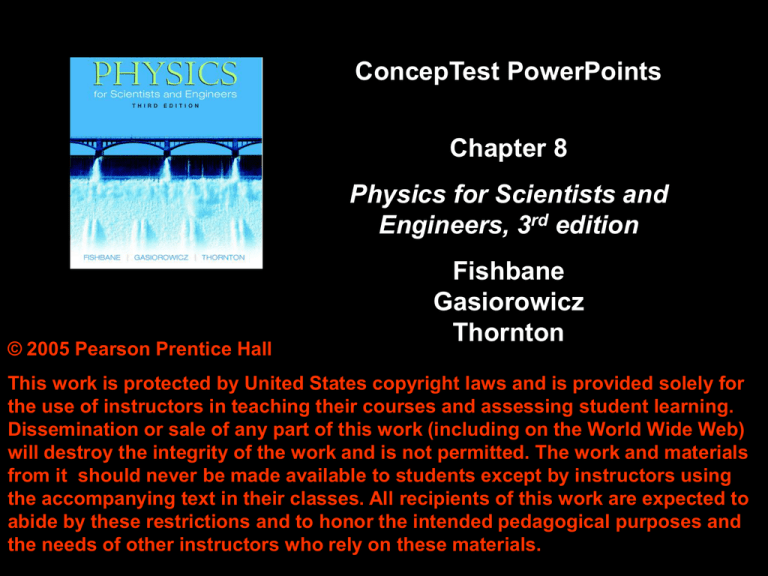
ConcepTest PowerPoints
Chapter 8
Physics for Scientists and
Engineers, 3rd edition
© 2005 Pearson Prentice Hall
Fishbane
Gasiorowicz
Thornton
This work is protected by United States copyright laws and is provided solely for
the use of instructors in teaching their courses and assessing student learning.
Dissemination or sale of any part of this work (including on the World Wide Web)
will destroy the integrity of the work and is not permitted. The work and materials
from it should never be made available to students except by instructors using
the accompanying text in their classes. All recipients of this work are expected to
abide by these restrictions and to honor the intended pedagogical purposes and
the needs of other instructors who rely on these materials.
An open cart rolls along a frictionless track while it is
raining. As it rolls, what happens to the speed of the cart
as the rain collects in it? (assume that the rain falls
vertically into the box)
1) speeds up
2) maintains constant
speed
3) slows down
4) stops immediately
A system of particles is known to have a total
kinetic energy of zero. What can you say about
the total momentum of the system?
) momentum of the system is
positive
2) momentum of the system is
positive
3) momentum of the system is
zero
4) you cannot say anything
about the momentum of the
system
A system of particles is known to have a total
momentum of zero. Does it necessarily follow
that the total kinetic energy of the system is
also zero?
1) yes
2) no
Two objects are known to have the same
momentum. Do these two objects necessarily
have the same kinetic energy?
1) yes
2) no
A net force of 200 N acts on a 100-kg boulder,
and a force of the same magnitude acts on a
130-g pebble. How does the rate of change of
the boulder’s momentum compare to the rate
of change of the pebble’s momentum?
1) greater than
2) less than
3) equal to
A net force of 200 N acts on a 100-kg boulder,
and a force of the same magnitude acts on a
130-g pebble. How does the rate of change of
the boulder’s velocity compare to the rate of
change of the pebble’s velocity?
1) greater than
2) less than
3) equal to
A small car and a large truck collide head-on
and stick together. Which one has the larger
momentum change?
1) the car
2) the truck
3) they both have the
same momentum
change
4) can’t tell without
knowing the final
velocities
Two boxes, one heavier than the other, are initially at rest
on a horizontal frictionless surface. The same constant
force F acts on each one for exactly 1 second. Which box
has more momentum after the force acts ?
1) the heavier one
2) the lighter one
3) both the same
In the previous question, which box has the
larger velocity after the force acts?
1) the heavier one
2) the lighter one
3) both the same
F
light
F
33%
33%
33%
heavy
1
2
3
In the previous question, which box has the
larger velocity after the force acts?
1) the heavier one
2) the lighter one
3) both the same
33%
1
33%
2
33%
3
You drive around a curve in a narrow one-way street at 30
mph when you see an identical car heading straight
toward you at 30 mph. You have two options: hit the car
head-on or swerve into a massive concrete wall (also
head-on). What should you do?
1) Hit the other car
2) Hit the wall
3) Makes no difference
4) Call your physics prof!!
5) Get insurance!
20%
1
20%
20%
2
3
20%
4
20%
5
A small beanbag and a bouncy rubber ball are dropped
from the same height above the floor. They both have the
same mass. Which one will impart the greater impulse to
the floor when it hits?
1) the beanbag
2) the rubber ball
3) both the same
33%
1
33%
2
33%
3
Consider two elastic collisions:
1) a golf ball with
speed v hits a stationary bowling ball head-on.
2) a
bowling ball with speed v hits a stationary golf ball headon. In which case does the golf ball have the greater
speed after the collision?
1.
2.
3.
1) situation 1
2) situation 2
3) both the same
v
v
33%
33%
33%
1
2v
2
1
2
3
A person stands under an umbrella during a rainstorm.
Later the rain turns to hail, although the number of
“drops” hitting the umbrella per time and their speed
remains the same. Which case requires more force to
hold the umbrella?
1) when it is hailing
2) when it is raining
3) same in both
cases
33%
1
33%
2
33%
3
A bowling ball and a ping-pong ball are rolling
toward you with the same momentum. If you
exert the same force to stop each one, which
takes a longer time to bring to rest?
1) the bowling ball
2) same time for both
3) the ping-pong ball
4) impossible to say
v
at rest
1
25%
25%
25%
2
3
25%
at rest
v
2
1
4
ConcepTest 8.10a Elastic Collisions I
Consider two elastic collisions:
1) a golf ball with speed v hits a
stationary bowling ball head-on.
2) a bowling ball with speed v
hits a stationary golf ball head-on. In
which case does the golf ball have the
greater speed after the collision?
Remember that the magnitude of the
relative velocity has to be equal before
and after the collision!
1) situation 1
2) situation 2
3) both the same
v
1
In case 1 the bowling ball will almost
remain at rest, and the golf ball will
bounce back with speed close to v.
In case 2 the bowling ball will keep going
with speed close to v, hence the golf ball
will rebound with speed close to 2v.
v
2v
2
A bowling ball and a ping-pong ball are rolling
toward you with the same momentum. If you
exert the same force to stop each one, for
which is the stopping distance greater?
25%
25%
25%
2
3
25%
1) the bowling ball
2) same distance for both
3) the ping-pong ball
4) impossible to say
v
at rest
at rest
1
v
2
1
4
Carefully place a small rubber ball (mass m) on top of a
much bigger basketball (mass M) and drop these from
some height h. What is the velocity of the smaller ball
after the basketball hits the ground, reverses direction
and then collides with small rubber ball?
1)
2)
3)
4)
5)
zero
v
2v
3v
4v
20%
1
20%
20%
2
3
20%
4
20%
5
ConcepTest 8.10b Elastic collisions II
Carefully place a small rubber ball (mass m)
on top of a much bigger basketball (mass M)
and drop these from some height h. What
is the velocity of the smaller ball after the
basketball hits the ground, reverses direction
and then collides with small rubber ball?
1) zero
2) v
3) 2v
4) 3v
5) 4v
• Remember that relative
3v
velocity has to be equal
m
v
v
before and after collision!
Before the collision, the
v
v
basketball bounces up
M
v
with v and the rubber ball
is coming down with v,
(a)
(b)
(c)
so their relative velocity is
–2v. After the collision, it Follow-up: With initial drop height h, how
therefore has to be +2v!!
high does the small rubber ball bounce up?
You tee up a golf ball and drive it down the fairway.
Assume that the collision of the golf club and ball is
elastic. When the ball leaves the tee, how does its speed
compare to the speed of the golf club?
1) greater than
2) less than
3) equal to
33%
1
33%
2
33%
3
A box slides with initial velocity 10 m/s on a
frictionless surface and collides inelastically
with an identical box. The boxes stick together
after the collision. What is the final velocity?
1)
2)
3)
4)
5)
10 m/s
20 m/s
0 m/s
15 m/s
5 m/s
20%
vi
M
M
20%
20%
2
3
20%
20%
M
M
vf
1
4
5
On a frictionless surface, a sliding box collides
and sticks to a second identical box which is
initially at rest. What is the final KE of the
system in terms of the initial KE?
1)
2)
3)
4)
KEf
KEf
KEf
KEf
=
=
=
=
KEi
KEi / 4
KEi / 2
KEi / 2
20%
20%
20%
20%
20%
vi
5) KEf = 2 KEi
vf
1
2
3
4
5
A uranium nucleus (at rest) undergoes fission
and splits into two fragments, one heavy and
the other light. Which fragment has the greater
momentum?
1) the heavy one
2) the light one
3) both have the
same momentum
4) impossible to say
1
2
25%
1
25%
25%
2
3
25%
4
A uranium nucleus (at rest) undergoes fission
and splits into two fragments, one heavy and
the other light. Which fragment has the greater
speed?
1) the heavy one
2) the light one
3) both have the
same speed
4) impossible to say
1
2
25%
1
25%
25%
2
3
25%
4
Amy (150 lbs) and Gwen (50 lbs) are standing
on slippery ice and push off each other. If
Amy slides at 6 m/s, what speed does Gwen
have?
(1)
(2)
(3)
(4)
(5)
150
lbs
2 m/s
6 m/s
9 m/s
12 m/s
18 m/s
20%
20%
20%
2
3
20%
20%
50 lbs
1
4
5
A cannon sits on a stationary railroad flatcar
with a total mass of 1000 kg. When a 10-kg
cannon ball is fired to the left at a speed of 50
m/s, what is the recoil speed of the flatcar?
1)
2)
3)
4)
5)
0 m/s
0.5 m/s to the right
1 m/s to the right
20 m/s to the right
50 m/s to the right
20%
1
20%
20%
2
3
20%
4
20%
5
When a bullet is fired from a gun, the bullet and
the gun have equal and opposite momenta. If
this is true, then why is the bullet deadly?
(whereas it is safe to hold the gun while it is
fired)
1) it is much sharper than the gun
2) it is smaller and can penetrate your
body
3) it has more kinetic energy than the
gun
4) it goes a longer distance and gains
speed
5) it has more momentum than the gun
20%
1
20%
20%
2
3
20%
4
20%
5
If all three collisions below are totally inelastic,
which one(s) will bring the car on the left to a
complete halt?
1)
2)
3)
4)
5)
I
II
III
II and III
all three
20%
1
20%
20%
2
3
20%
4
20%
5
You are lying in bed and you want to shut your bedroom
door. You have a superball and a blob of clay (both with
the same mass) sitting next to you. Which one would be
more effective to throw at your door to close it?
1) the superball
2) the blob of clay
3) it doesn’t matter -- they
will be equally effective
4) you are just too lazy to
throw anything
25%
1
25%
25%
2
3
25%
4
Where is center of mass of a baseball bat
located?
1) at the midpoint
2) closer to the thick
end
3) closer to the thin end
(near handle)
4) it depends on how
heavy the bat is
25%
1
25%
25%
2
3
25%
4
Two equal-mass particles (A and B) are located
at some distance from each other. Particle A is
held stationary while B is moved away at speed
v. What happens to the center of mass of the
1) it does not move
2) it moves away from A with
speed v
3) it moves toward A with speed
v
4) it moves away from A with
speed 1/2 v
5) it moves toward A with speed
20%
20%
20%
2
3
20%
20%
1/2 v
1
4
5
The disk shown below in (1) clearly has its center of mass at the
center. Suppose the disk is cut in half and the pieces
arranged as shown in (2).
Where is the center of mass of (2) as compared to (1) ?
1)
2)
3)
4)
higher
lower
at the same place
there is no
definable CM in this
case
(1)
X
CM
25%
25%
25%
2
3
25%
(2)
1
4
ConcepTest 8.20 Center of Mass
The disk shown below in (1) clearly
has its center of mass at the center.
1) higher
Suppose the disk is cut in half and
the pieces arranged as shown in (2).
3) at the same place
2) lower
4) there is no definable
CM in this case
Where is the center of mass of (2)
as compared to (1) ?
The CM of each half is closer
to the top of the semi-circle
than the bottom. The CM of
the whole system is located
at the midpoint of the two
semi-circle CM’s, which is
higher than the yellow line.
(1)
X
CM
(2)
CM



